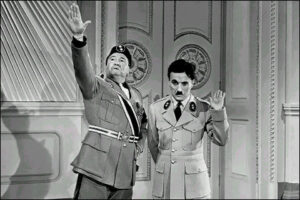Chaplin relies on physical comedy and Kamra on sharp dialogue—their intent is the same: to speak truth to power through art.
Published Mar 28, 2025 | 3:00 PM ⚊ Updated Mar 28, 2025 | 3:00 PM

Standup comedian and political satirist Kunal Kamra is being targeted for a joke referring to Maharashtra deputy chief minister Eknath Shinde as a "gaddar" (traitor) in his latest stand-up video, "Naya Bharat," on YouTube.
Synopsis: In an era of echo chambers and manufactured consent, satirists like Chaplin and Kamra are vital. They don’t just make us laugh; they make us see. Whether it’s 1940s fascism or 2020s populism, the playbook of power remains similar—and so does the role of art in challenging it.
Kunal Kamra’s latest episode of Naya Bharat on YouTube has sparked a heated debate, much like other satirical works throughout history that have dared to challenge authority.
As I watched the controversy unfold, I was reminded of Charlie Chaplin’s 1940 classic The Great Dictator—a film that boldly criticised Adolf Hitler when he was still in power.
Chaplin took an immense risk by using satire to expose the absurdity of dictatorship, and his film remains a timeless masterpiece.
The similarities between Chaplin’s The Great Dictator and Kamra’s Naya Bharat are striking. Both use satire to critique leadership, exaggerate reality to highlight injustices and adopt the perspective of the common man resisting a powerful system.
While their approaches differ—Chaplin relies on physical comedy and Kamra on sharp dialogue — their intent is the same: To speak truth to power through art.
Both The Great Dictator and Naya Bharat use humour as a weapon against oppressive systems. Chaplin created the character of Adenoid Hynkel, an exaggerated version of Hitler, mimicking his mannerisms and ideology to expose their absurdity.
Through this portrayal, Chaplin stripped the dictator of his fearsome aura, reducing him to a figure of ridicule.
Kamra, in Naya Bharat, employs similar tactics. His satire targets political leaders and the state of governance in India, exposing what he perceives as contradictions and failures. By making his audience laugh, he also makes them think—an essential function of political satire.
His work, like Chaplin’s, challenges the image of unquestionable authority and forces us to see those in power as fallible individuals.
Satire often amplifies reality to make its point. Chaplin’s famous “globe dance” scene — where Hynkel plays with an inflatable globe as if the world were his toy — a masterstroke in demonstrating the megalomania of dictators. The scene is playful yet chilling, showing the fragility of a world controlled by a single man’s whims.

Charlie Chaplin as Adenoid Hynkel (right) with Jack Oakie as Benzino Napaloni in The Great Dictator. (Wikimedia Commons)
Kamra, while relying more on verbal wit and situational comedy, follows the same principle. He takes real-life issues — nationalism, bureaucracy, governance — and stretches them to absurdity, making us question the status quo. The use of exaggeration makes uncomfortable truths harder to ignore.
Neither The Great Dictator nor Naya Bharat is just about entertainment; both contain sharp social commentary. Chaplin’s film, released during World War II, tackled fascism, anti-semitism, and the loss of human dignity in a world consumed by war.
His famous closing speech — a heartfelt plea for peace, democracy, and compassion—remains one of the most powerful monologues in cinematic history.
Kamra’s work, though more localised, engages in a similar kind of critique. He questions the direction in which India is heading, highlighting concerns about democracy, governance, and nationalism. His satire forces the audience to confront uncomfortable realities, much like Chaplin’s film did in its time.
A key reason The Great Dictator resonated with audiences is that Chaplin played both the dictator and the oppressed Jewish barber. This dual role highlighted the stark contrast between unchecked power and the struggles of the powerless. The barber, though an ordinary man, ultimately delivers the film’s most profound message—one that outshines the dictator’s bombastic rhetoric.
Kamra also embraces the “little guy” persona. His satire is not just about critiquing power but also about speaking from the perspective of the common citizen. His work reflects the concerns of people who feel unheard in a system dominated by powerful interests. Like Chaplin’s barber, Kamra represents those who push back, however small their voice may seem.
The risk of speaking truth to power
Chaplin faced FBI surveillance and was eventually exiled from the US during the McCarthy era. Kamra has been slapped with legal cases, social media bans, and relentless trolling.
Yet, both persist because satire is not just entertainment — it’s resistance.
In an era of echo chambers and manufactured consent, satirists like Chaplin and Kamra are vital. They don’t just make us laugh; they make us see. Whether it’s 1940s fascism or 2020s populism, the playbook of power remains similar—and so does the role of art in challenging it.
As Chaplin said: “Dictators free themselves, but they enslave the people.” Satire reminds us that we don’t have to accept that fate.
(Kumar S is an independent journalist and translator with 20 years of experience in Kannada media. He has authored four books, including two poetry collections. Throughout his career, Kumar has contributed to various publications such as Vijay Karnataka, Kannada Prabha, and Vijayavani, and has worked across print, visual, and digital media platforms. Since 2018, he has been dedicated to fact-checking and has conducted training sessions for aspiring journalists. An accomplished author, Kumar is also a cinephile and tech enthusiast with a deep love for literature. Views are personal. Edited by Majnu Babu).
